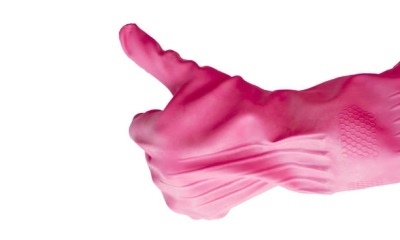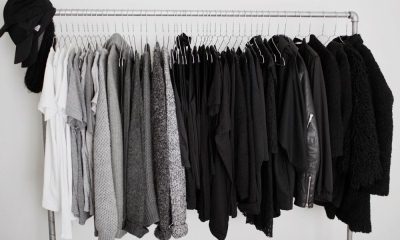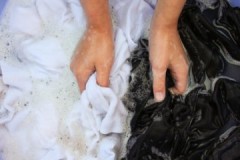We answer the question: is it possible to wash black clothes with gray ones and how to do it correctly?
 In order to save time, many housewives decide to wash gray and black clothes together.
In order to save time, many housewives decide to wash gray and black clothes together.
Sometimes such an experiment does not end well, and dark spots appear on light fabric.
To prevent this from happening, you need to understand in which cases simultaneous washing is prohibited, and when it is permissible.
So, can black clothes be washed along with gray ones? Let's figure it out.
Content
Joint processing
It is no secret that it is recommended to process black items separately from light items. However, there are exceptions to each rule. These secrets can be used as needed.
General tips for washing black clothes find here.
When possible?
Combined wash of gray and black items possible in the following cases:
 there will be fast processing of products at low water temperatures, its indicator should not exceed 30 degrees;
there will be fast processing of products at low water temperatures, its indicator should not exceed 30 degrees;- joint spinning of things is not supposed;
- black items are not new and have undergone a significant number of washings;
- gray things are not light, but dark - if their color is close to black, then washing together is possible.
A concentrated saline solution helps preserve the color and prevent it from washing out. Dissolve 2-3 tbsp in 1 liter of water. l. salt and soak the thing in it for 2-3 hours. Thanks to this procedure, the likelihood of pigment leaching is reduced.
When is it forbidden?
Do not load products into the washing machine drum at the same time under the following circumstances:
- The black thing is new. On first contact with water, even permanently colored fabrics release pigment. In such a situation, molting cannot be avoided.
- If the products need soaking. The longer they stay in contact with each other, the higher the probability of color transition.
- The molt test is positive. It is not difficult to carry it out. A piece of black cloth should be moistened and rubbed with a cotton pad. If fingerprints appear on it, the test has failed.
- If one thing is sewn from natural fabric, and the other from synthetics. The pigment is washed out more intensively from artificial fibers. Wool is especially susceptible to shedding.
Machine wash rules
If it is impossible to refuse the simultaneous washing of things of different shades, then you must strictly follow the following algorithm of actions:
 turn the products to the wrong side;
turn the products to the wrong side;- place them in the drum of the washing machine;
- if possible, use 2 bags for washing, sorting things according to them;
- set a suitable program (gentle or delicate mode);
- you can adjust the machine manually by setting the following parameters: water temperature 20-30 degrees, spin speed - 500 rpm;
- pour liquid detergent into the compartment, or use gel capsules, they are placed in the drum along with things;
- start a wash cycle;
- immediately after its completion, things are removed from the machine and sent to dry.
The powder should not contain bleaching ingredients. They help to wash out pigment from fabric fibers.
Drying features
To prevent black products from staining the gray fabric, they must be dried separately. It is forbidden to hang things with an overlap, because dark spots will appear at their junctions... Products must be turned on the wrong side.
It is not recommended to hang dark items on heating devices. This will lead to the appearance of a specific shine and creases.
Important recommendations
To process things without undesirable consequences, you need to adhere to the following tips:
 Use fabric softener labeled "Color". This allows the pigment to be fixed in the fabric and reduces the chance of shedding.
Use fabric softener labeled "Color". This allows the pigment to be fixed in the fabric and reduces the chance of shedding.- Do not soak materials of different shades in hot water.
- Hand washing will reduce the likelihood of shedding.
- Before any contact with water, things are turned out to the wrong side.
- For joint processing of dark gray and black products, you can use special gels, for example, Lasko magic black (1 liter of detergent costs about 200 rubles). Such formulations help prevent leaching of the pigment.
Conclusion
Washing gray and black items together is undesirable, but possible. If you observe the temperature regime and choose the right detergent, you will be able to avoid unwanted consequences in the form of pigment transfer from one fabric to another.


